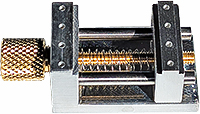
Vitreous Carbon Discs and Graphite Discs / Plates
Vitreous Carbon Discs and Graphite Discs / Plates

Vitreous Carbon Discs
Introduction
The standard SEM stubs used in an SEM are nearly all made from aluminum and sometimes brass. This is fine for many applications if the sample is large enough and can be mounted directly on the stub. However, for small samples, powders, particles in solutions and fibers the finish and the material of the stub can interfere with imaging or X-ray analysis.
Carbon (graphite) or vitreous carbon discs to prevent interference.
To prevent interference of the stub surface you can place a carbon (graphite) disc or a vitreous carbon disc between the stub and the specimen and mount the specimen directly on these discs. Both discs varieties (also called planchets) form a protective shield and prevent undesirable X-ray and backscattered electron signals. There are also graphite plates to shield the sample from signals coming from the SEM stage. They can also be used as substrate for X-Ray Microscopy (XRM) or X-Ray Microtomography (MicroCT).
Differences between vitreous carbon discs and carbon (graphite) discs.
Vitreous carbon is superior in hardness, surface finish, mechanical and chemical stability but it is more expensive than carbon discs. The table below will give guidance to which material is best for the application at hand. Generally speaking, vitreous carbon is the better choice, but for less demanding applications carbon (graphite) discs will do just fine.
|
Vitreous Carbon Disc |
Carbon (Graphite) Disc / Plate |
Smooth surface |
V |
X |
Hard Surface |
V |
X |
Easy to clean and re-use |
V |
O |
SE Imaging |
V |
X |
BSE Imaging |
V |
V |
X-ray Microanalysis |
V |
V |
Spectral Analysis |
V |
O |
Aqueous Solutions |
V |
X |
Pricing |
O |
V |
High Purity |
V |
V |
Conductivity |
V |
V |
Packaging |
Each |
Pkg/10 or Pkg/5 |

Vitreous Carbon Discs
Vitreous carbon, glassy carbon or glass-like carbon has many application in research, science, metallurgy and chemical analysis. For microscopy related techniques this material has a number of desirable properties which makes it an ideal substrate material:
- Vitreous carbon combines the glassy, ceramic properties of carbon with those of graphite
- It is a conductive material
- It is a high purity, hard, non-porous, corrosion resistant material
- Impermeable to gasses and / or liquids
- Good thermal stability and great resistance against thermal shock
- Smooth surface
- Less hydrophobic than graphite
For microscopy and analytical applications it is important to know that the smooth surface gives rise to low electron signals, both for secondary electrons (SE) and backscattered electrons (BSE). The high purity carbon material contributes only C to the X-ray spectrum which makes vitreous carbon ideal for EDX and WDX investigations of small samples, powders, particulates, and fibers. Vitreous carbon acts less hydrophobic than graphite and is more suitable to prepare particles in aqueous solution where the solution will spread more evenly over the surface.
Physical Properties of HG Grade Vitreous Carbon |
|
Maximum Temperature (vacuum or inert gas),ºC |
3000 |
Density, g/cm3 |
1.42 |
Hardness, Vickers, HV |
230 |
Permeability Coefficient, cm2/s |
10-9 |
Open porosity, % |
0 |
Young's Modulus, GPa |
35 |
Compressive Strength, Gpa |
0.48 |
Flexural Strength, Gpa |
0.26 |
Thermal Conductivity (30ºC) W/km |
6.3 |
Electrical Resistance (30ºC), Ωµm |
45 |
Thermal Expansion Coefficient (20-200ºC), /K |
2.6x10-6 |
Surface finish of Vitreous Carbon Discs
The Vitreous carbon discs are lapped on one side to provide a smooth surface, typically 0.05 – 0.01μm. They can be used many times after cleaning and lapping. For lapping we suggest to use either diamond lapping film with water or SiC in water suspension.
Purity, handling and sizes of the vitreous carbon discs.
The high purity vitreous carbon material has less than 30ppm impurities in total. Typical impurities for vitreous carbon can be:
- Ca 10ppm
- Si 14ppm
- Al, Fe, K, Na, Ni and Sn all less than 1ppm
- Ba, Be, Bi, Cd, Co , Cr, Cu, Mg, Mo, Sr, Ti, V, W, Zn and Zr all less than 0.1ppm
The sizes available are 10, 12.7, 19.0 25.0 and 32mm diameters which fit on a the most popular pin stubs and cylinder mounts. The discs have a thickness or either 2 or 3mm and can be easily handled. For SEM application we suggest to use a conductive strong carbon glue (preferable) or silver glue to mount the vitreous carbon discs on the SEM stubs.
Graphite Discs / PlatesThe graphite planchets or discs consists of high purity, graphitized soft spectral grade carbon. This material is softer and is less strong than the vitreous carbon materials. When handled with care it is still an excellent substrate for SEM imaging and X-ray micro-analysis. The carbon discs exhibit a low contribution for BSE imaging and a pure background with only the contribution of carbon for EDX and/or WDX analysis. The standard finish is not a smooth as with the vitreous carbon discs and is visible in SE imaging. Carbon discs are also more porous and more hydrophobic than vitreous carbon discs.

Physical Properties of Spectral Grade High Purity Carbon |
|
Density, g/cm3 |
1.6 |
Hardness, Shore |
33 |
Porosity, % |
29 |
Young's Modulus, Mpa |
22 |
Compressive Strength, Mpa |
48 |
Flexural Strength, Mpa |
27 |
Electrical Resistance, Ωμm |
65 |
Thermal Expansion, /K |
1.9x10-6 |
Surface finish of graphite discs
The standard ground finish on one side is 0.80μm. The finish can be easily improved by lapping the discs on fine 10um grinding or lapping paper with water as lubricant; the surface roughness of the soft graphite material can be improved to 0.05μm or better.
Purity, handling and sizes of graphite discs
The high purity carbon used for the carbon planchets or discs only has impurities of less than 2ppm with 1ppm or less for each single element. The impurities can be B, Mg, Al, Si, Ca or Fe.
The sizes available are 10, 12.7, 25.4 and 32mm diameters, all with a thickness of 1.6mm. These 4 sizes can be used on all popular SEM stubs and mounts. Since the material is relatively soft, we strongly suggest to glue the planchets on SEM stubs or mounts with a conductive carbon or silver glue. We would like to discourage the use of SEM stubs fully made of carbon; the material is soft so the pin can easily break off and during handling the soft carbon can easily shed material which can potentially cause contamination. Carbon discs glued on SEM stubs combine the advantages of the low contributing carbon background, low costs, easy handling and storage with the sturdy aluminum base. When the top of the specimenstub is completely covered by the graphite discs there is no imaging or analytical contribution of the supporting SEM stub.
Graphite plates
The graphite plates are useful for larger specimen support or if the sample needs to be shielded against X-ray or backscattered electron signals originating from the SEM stage. The surface finish for the graphite plate is less fine as for the graphite planchets; the plates are cut from thicker plates to reduce thickness and weight. Made from high purity graphite material, they are available in sizes 100 x 50 x 2mm and 100 x 100 x2mm. For increased mechanical stability, the graphite plates can be mounted metal substrates. The graphite plates are sold in pkg/5.
Ordering Information for the high purity Vitreous Carbon Discs
|
|||||||||||||
|
|||||||||||||
|
|||||||||||||
|
|||||||||||||
|
|||||||||||||
|
|||||||||||||
|
|||||||||||||
|
|||||||||||||
|
|||||||||||||
|
|||||||||||||
|
|||||||||||||








